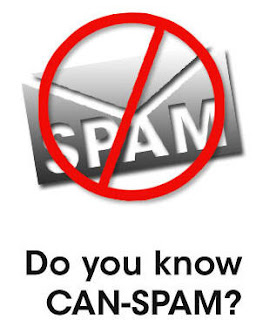 Pornography And Marketing Act of 2003, is one of the most important online marketing topics. To follow is a CAN-SPAM QUIZ. Test your knowledge to make sure your emails are compliant.
Pornography And Marketing Act of 2003, is one of the most important online marketing topics. To follow is a CAN-SPAM QUIZ. Test your knowledge to make sure your emails are compliant.You can also check out my other CAN-SPAM related blog post, CAN-SPAM: Just The Facts, by clicking here.
This quiz is from Bronto.com. You can see the original quiz by clicking here.
QUESTION 1
CAN-SPAM is only applicable in the United States and overrides any state level spam laws.
- True
- False
QUESTION 2
Updates to CAN-SPAM are managed and produced by the FCC.
- True
- False
QUESTION 3
Which of the following is not acceptable under CAN-SPAM?
- A physical street address in the content of the sender
- A PO box address in the content of the sender
- Having an opt-out link
- Sending marketing email to anyone regardless of whether they’ve actually opted-out
QUESTION 4
What’s the maximum number of pages a user is allowed to land on or be redirected to after clicking on the unsubscribe link in an email?
- One page
- Two pages
- Three pages
- Four Pages
QUESTION 5
How quickly after a user unsubscribes must you remove them from your marketing lists?
-Five days
-Ten days
-One week
-One month
QUESTION 6
How long must the unsubscribe link in an email remain active for a user to click on it?
-Five days
-Ten days
-One week
-One month
QUESTION 7
Transactional email is defined as that which you think the recipient would most likely convert on.
-True
-False
QUESTION 8
Transactional email is exempt from CAN-SPAM.
-True
-False
QUESTION 9
Which of the following headers must accurately reflect the sender?
- The friendly from
- From address
- Subject
- All of the Above
QUESTION 10
You must send to at least the following amount for CAN-SPAM to be in force?
- Any Volume
- 100
- 1,000
- 10,000
QUESTION 11
Violation of CAN-SPAM can result in monetary fines and possible jail time.
-True
-False
THAT'S IT!
Keep on reading to view the answers.
Keep on reading to view the answers.
Question 1
The answer is “True.”
CAN-SPAM was written into law in 2003 as a federal measure to ensure that all email adequately identifies its origin, allows a user to remove themselves from future mailings and provides the government and ISPs a right to action against anyone not following CAN-SPAM requirements.
Question 2
The answer is “False”.
While the FCC contributes to CAN-SPAM via email sent to cell devices, the Federal Trade Commission (FTC) owns and updates the core requirements of CAN-SPAM. The FTC is also the governing body in legal prosecutions.
Question 3
The Answer is “Sending marketing email to anyone regardless of whether they’ve actually opted-out.” CAN-SPAM is very clear that once a recipient has opted out of receiving your email, you may not contact them again for further marketing opportunities. With an unsubscribe, this is akin to a Do-Not-Call list with telephone numbers.
Question 4
The Answer is “One page.”
To avoid senders having overly complicated or confusing opt out mechanisms to keep list attrition at a minimum, a sender is allowed to have the recipient take one action after landing on the unsubscribe page from an opt-out clickthrough. At that point, they can click on a confirm button, check a box, etc., but a sender cannot require them to sign into an account and perform other actions to be removed from the list or require a fee.
Question 5
The Answer is “Ten days.”
You must remove a recipient from mailing lists or suppress sending to them within 10 days of receipt of their opt-out request as mandated by law.
Question 6
The Answer is “One Month.”
To ensure that recipients have enough time to actually click on an unsubscribe link in an email, you must support the unsubscribe link and the resulting landing page for at least 30 days.
Question 7
The Answer is “False.”
CAN-SPAM clearly defines transactional email as one which “facilitates an agreed-upon transaction or updates a customer in an existing business relationship.” This definition prohibits marketing messages from being labeled as transactional although it does allow for marketing content in a transactional email.
Question 8
The Correct Answer is “True.”
Since transactional email falls under strict definition by the FTC, it is exempt from the commercial email restrictions. But, it is advised that a sender get input from someone who’s an expert in email law to certify that the content does apply to the transactional definition.
Question 9
The Answer is “All of the Above.”
All of these must accurately reflect the originator of the email message. Failure to do so is considered fraudulent and in direct conflict of the transparency spirit of the law.
Question 10
The Answer is “Any Volume.”
Any amount of email sent, regardless even if it’s just to a single recipient, is covered by CAN-SPAM. There are no volume thresholds.
Question 11
The Answer is “True.”
Violation of CAN-SPAM can result in monetary fines and jail time depending on the number of offenses and intent of the sender. Over the years, many people have received either or both as they’ve been found guilty of breaking CAN-SPAM regulations. Also, a sender in violation can face civil damages from private ISPs attempting to recoup damages lost by sending mail to their recipients.



























while it is of course true that CAN-SPAM overrides less stringent state laws, isn't it also true that state laws that go beyond CAN-SPAM must be obeyed? It never came to fruition but I'm sure many of us remember the scare from Mass. where they almost passed a law prohibiting sending marketing email of any kind to minors.
ReplyDelete